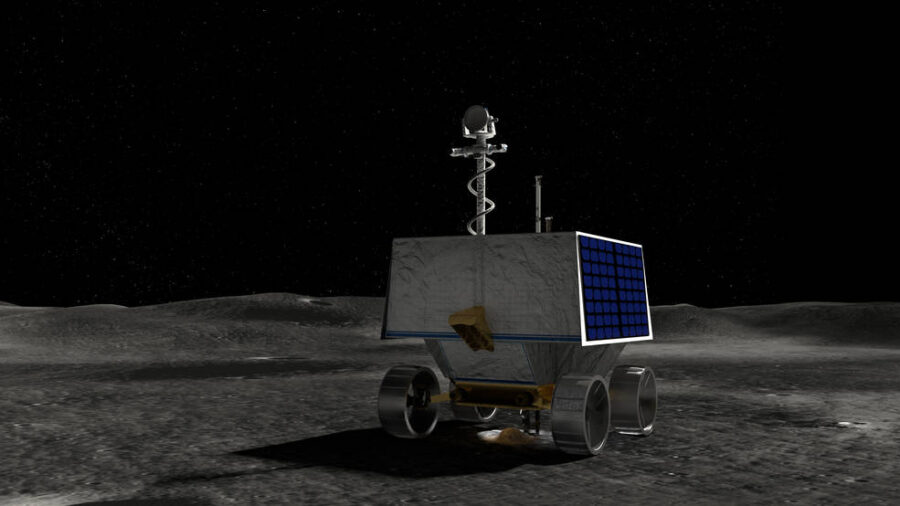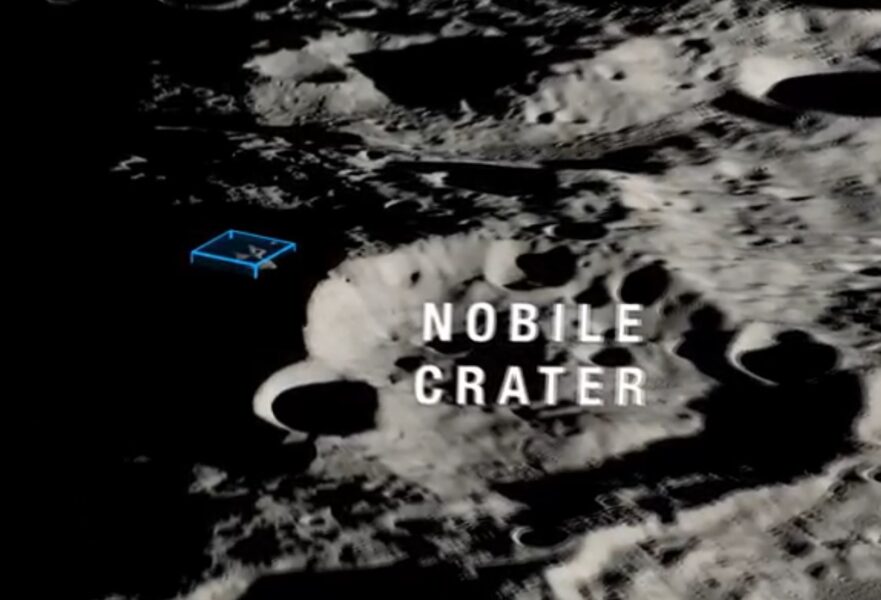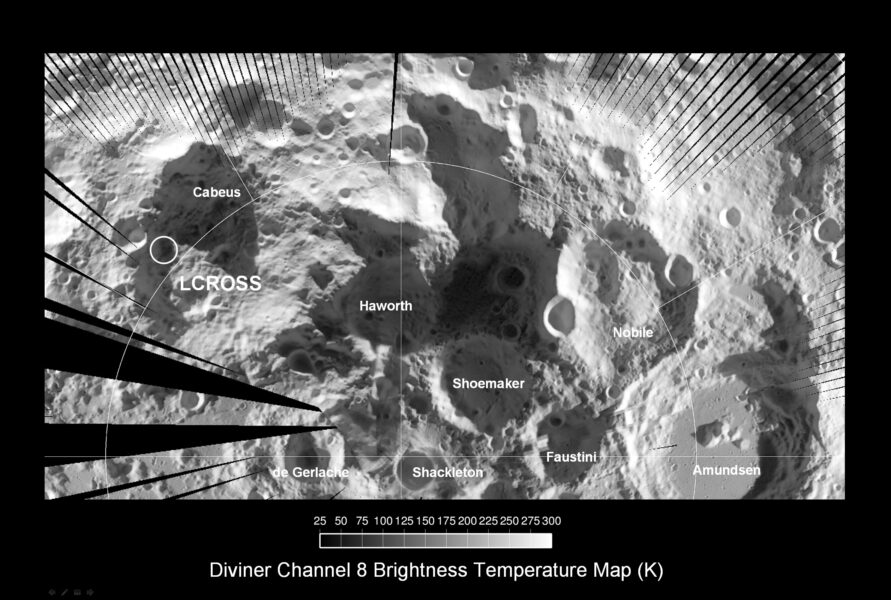NASA’s VIPER rover will land and search for water ice in the unexplored Nobile region at the Moon’s south pole.

NASA / Daniel Rutter
The U.S. is about to return to the Moon in a big way. NASA has announced one of the first steps in the next generation of lunar exploration: a landing site for the Volatiles Investigating Polar Exploration Rover (VIPER).
The site is on the western edge of Nobile crater, near the lunar south pole. The crater was named after Italian polar explorer Umberto Nobile. The targeted area of study covers 93 square kilometers (36 square miles); VIPER, which is set to launch in 2023, is expected to traverse 16 to 24 km (10-15 miles) during its primary mission.
The three other finalists in the running in the same region included Haworth Crater, a ridge that runs between Shackleton and de Gerlache craters, and Shoemaker Crater.
NASA based the final site selection on four criteria: Earth visibility, which is necessary for direct line-of-sight communication; sunlight access, for solar power; terrain, for flexibility during traverse; and the scientific value of a site expected to contain water ice.

NASA-Ames (screen capture)
“Once on the lunar surface, VIPER will provide ground truth measurements for the presence of water and other resources at the Moon’s south pole,” said NASA's associate administrator Thomas Zurbuchen (NASA-HQ) in a recent press release. “The data VIPER returns will provide lunar scientists around the world with further insight into our Moon’s cosmic origin, evolution and history.”
VIPER will search for water ice on the lunar surface in permanently shadowed regions around the lunar south pole. The science collected by VIPER will not only help predict where ice might be present on the Moon, based on similar terrain, but will also help define a global resource map.
The mission will visit at least six separate sites of interest during exploration, and drill and sample in at least three locations. Unlike Perseverance and Curiosity on Mars, communications with VIPER will be carried out from Earth in near full-time.
“Our evaluation of the landing site was driven by science priorities,” says Anthony Colaprete (NASA-Ames Research Center) in a recent press release. “We seek answers to some pretty complex questions and studying these resources on the Moon that have stood the test of time will help us answer them.”
The primary mission duration is planned to last 100 days, powered by solar-charged batteries. The 430-kilogram (950-pound) rover is currently under development at NASA's Ames Research Center.

NASA/LRO/Diviner
VIPER is the descendant of the previously proposed Resource Prospector mission, which was canceled in 2018. The mission was revived as part of NASA's Commercial Lunar Payload Services (CLPS) program, and relies on private aerospace companies Astrobotic Technology and SpaceX to provide the Griffin lander and the Falcon Heavy rocket, respectively.
Ice on the Moon
Missions such as India’s Chandrayaan 1 orbiter and NASA’s Lunar Crater Observation and Sensing Satellite (LCROSS) have detected tantalizing evidence for the existence of hydroxide at the lunar poles, hinting at the presence of water ice in permanently shaded regions such as crater floors. Large deposits of water ice strewn on the surface as a result of ancient cometary impacts could be a valuable in situ resource for future astronauts.
Instruments aboard VIPER are designed to find ice on the surface or below. A percussive drilling mechanism, dubbed the Regolith and Ice Drill for Exploring New Terrains (TRIDENT), holds on to deposits of material, bringing them up and depositing them on the surface for further close-up analysis.
VIPER has three instruments to analyze volatiles (such as water ice) and mineral composition, including the Mass Spectrometer Observing Lunar Operations; the Near Infrared Volatiles Spectrometer System, which will include a context camera to watch the drill during deployment; and the Neutron Spectrometer System which can detect water down to a sensitivity of 10 of parts per million.
VIPER will also include navcams on top masts, stereo cameras, and hazcams for hazardous terrain avoidance. Expect VIPER to document a unique perpetual twilight landscape quite unlike previous lunar landers, with boulders casting long stark shadows in the distance.
Unlike the rocker-bogie wheel system used on Curiosity and Perseverance, VIPER has four wheels each with independent suspension and active steering, meaning it can "crab walk" sideways. VIPER also has two different speed regimes: a slow 10 cm per second (4 inches per second) during science operations, and twice that speed for moving from point-to-point.

NASA-Ames Research Center
Fly Me to the Moon
VIPER will be NASA’s first automated rover on the Moon. But before it arrives, there will be several other lunar landing attempts, including NASA's first CLPS missions courtesy of Intuitive Machines’ Nova-C Lander. (Another CLPS mission, Astrobotic’s Peregrine Lander, is now due to launch in 2023). Also next year, Russia hopes to field its Luna 25 lander on the Moon, and Japan's Aerospace Exploration Agency plans to send up its Smart Lander for Investigating the Moon (SLIM).
Later on, India and Israel may attempt missions following failed landing attempts in 2019, India with Chandrayaan 3 and Israel with the Firefly Aerospace Genesis lander, built on the previous Beresheet design, tentatively renamed Blue Ghost.
NASA also plans to send the Lunar Trailblazer orbiter to map surface ice on the Moon in 2025. As a smaller mission that's part of NASA's SIMPLEx program, Trailblazer will rideshare with the larger solar physics IMAP mission.
Lunar orbit will become a busy space as well. NASA still plans for the inaugural flight of an uncrewed Space Launch System (SLS) rocket in (as of this writing) December 2021, which will take a trans-lunar injection trajectory around the Moon and field 10 smallsats. SLS is the rocket that will ultimately take U.S. astronauts back to the Moon.
First up, though, will be the CAPSTONE lunar orbiter, set to launch from NASA Wallops atop a Rocket Lab Electron rocket on October 20, 2021. CAPSTONE is a pathfinder mission, ahead of the full-scale crewed Lunar Gateway platform set to begin construction on 2024.
There are some exciting years of lunar exploration ahead, and VIPER’s exploration of the Nobile Crater region is one of many leading the way.
 5
5
Comments
Andrew James
September 22, 2021 at 7:28 pm
Umm.... "The U.S. is about to return to the Moon in a big way." But so is China and Russia - and China probably even more aggressively. China National Space Administration (CNSA) has big plans, with Chang'e 7 to the south lunar pole in 2024 - even having a mini-flying probe with ice detectors. VIPER's instrumental abilities are relatively limited, and is a 'quick fix' responding these Chinese missions.
As for sharing data universally is unlikely for strategic reasons. China/Russia/ESA? will unlikely be very cooperative because of their plans for 2035 lunar base (International Lunar Research Station (ILRS)), now envisaged to start as early as 2026.[1] Any U.S. participation has already been announced as 'rejected' by China's PLA.
Chinese name for Moon is zh (月), and won't be just U.S. alone. Space Race V2.0 has already begun!
You must be logged in to post a comment.
Anthony Barreiro
September 23, 2021 at 5:44 pm
Since 2011 US law (the Wolf amendment) has forbidden NASA from cooperating with the Chinese government or Chinese-affiliated organizations, unless NASA gets an exemption from the US Federal Bureau of Investigation and Congress. NASA has never even applied for a waiver. The purpose of the law is to prevent China from acquiring technology with potential military applications. The effect, in my opinion, has been to accelerate the development of a robust independent Chinese space program.
By the way, CNSA rovers are incredibly cute! At least in these illustrations, Viper looks like a storage container on wheels. Couldn't they at least give it an anthropomorphic stereo mastcam?
You must be logged in to post a comment.
Andrew James
September 25, 2021 at 5:47 am
"...2011 US law (the Wolf amendment) has forbidden NASA from cooperating with the Chinese government..."
True, but the decree from China was more after the Cox Report in mid-June 1999. China's PLA 'counter ban' was in December 2016.
A lot more hinges on the Artemis Accords, which China will not support because of its own national resources.
You must be logged in to post a comment.
Anthony Barreiro
September 26, 2021 at 5:06 pm
Certainly the different national space programs contributing to the Artemis mission should have clear agreements about basic principles and procedures. But it's hard for me to imagine why the Chinese government would agree to cooperate with NASA when NASA can't cooperate with CNSA.
The fundamental provisions of the Artemis agreement are just restatements of existing international agreements such as the Outer Space Treaty, which both the United States and China have ratified. Rather than trying to get China to sign on to a new agreement spearheaded by the US, I think it would probably be more fruitful to work through the UN to update the Outer Space Treaty.
You must be logged in to post a comment.
Andrew James
September 27, 2021 at 4:29 am
Agreed. Not god for humanity though...
You must be logged in to post a comment.
You must be logged in to post a comment.